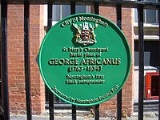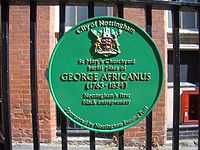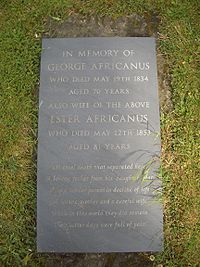
George Africanus
Encyclopedia
George John Scipio Africanus (c. 1763–1834) was a West Africa
n negro
slave
who became a successful entrepreneur in Nottingham
.
, which became a British
colony
in 1787.
It is believed that George arrived in England
in early 1766. On 31 March 1766, he was baptized George John Scipio Africanus, and described as a negro boy belonging to Benjamin Molineux of Molineux House
, in the Collegiate church of St Peter in Wolverhampton
.
Benjamin Molineux began educating George at age three. After his death in 1772, his eldest son, also named George, inherited the estate. George Molineux took responsibility for raising and educating the child. Growing up, George Africanus probably worked as a servant in the George Molineux family household, before becoming apprenticed to be a Brass founder.
As an adult, George Africanus moved to Nottingham, a place familiar to his adopted family. Benjamin Molineux's grandfather was Darcy Molineux (1652-1716), served as High Sheriff of Nottinghamshire
in 1687, and Deputy Lieutenant of Nottinghamshire between 1698-1702. Darcy Molineux raised George Molineux's father, John (1685-1754), in Mansfield
, Nottinghamshire, before settling in Wolverhampton around 1700. The family Molineux came from Teversal
near Mansfield in the county of Nottinghamshire.
George Africanus may have become interested in Nottingham after visiting on the way home from the funeral. A relative in his adopted family, Sir William Molineux, 6th Baronet of Teversall
, died near Manfield in 1781. Members of the Wolverhampton Molineux family, including George Africanus, might have passed through Nottingham town center, a city of 18,000 people then, full of beautiful open-air gardens and pleasing surroundings.
. They started up a business as a servant’s register office at 28 Chandlers Lane around 1793, where they also lived all their lives.
George Africanus appears to have operated the Servants' Register Office at his home on Chandlers Lane with his wife Esther from 1793 until his death 1834. She remained in the house until her death in 1853. If the business was not bringing in sufficient income, George might have performed other jobs for support. Their 1788 marriage bond document states that George was a Brass Founder by trade. Trade Directories of the time list him as a waiter and laborer as well. They had seven children, but only one lived to become an adult .
After his wife Ester died on 12 May 1853, a notice appeared in the Nottingham Review stated: "Yesterday (Thursday), aged 85 years, Mrs. Africanus, for upwards of sixty years proprietor of the Servants' Register Office in Chandlers Lane." If this account is correct, then Ester ran the Servants' Register Office on Chandler’s lane from at least 1793. George Africanus bought 28 Chandlers Lane and adjoining properties in Bluchers Yard for £380 on 24 October 1829.
While no descendants carry the Africanus family surname, his bloodline continued for some time. Daughter Hannah married Samuel Cropper (1802-1886/7), a watch and clock maker, at St. Mary's Church, Nottingham
, in 1825. They had three children, Sarah Ann Cropper (1825-1842), George Africanus Cropper (1838-1839) and Esther Africanus Cropper (1840-1911).
Granddaughter Esther married Charles Edward Turnbull at St. Mary's Church, Nottingham
, on September 28, 1865. They lived at 9 St. Paul's Crescent, St. Pancras, London. Esther died at age 69 in Kingston, Surrey. The 1881 census indicates that Esther had three children: Arthur (age-14), Fredrick (13), and Margaret Hannah (9).
According to the Last Will and Testament of George Africanus, he was unhappy with Hannah’s marriage to Samuel Cropper. Hannah and Samuel Cropper lived apart for years until after the death of George Africanus. The 1841 census shows that Hannah and Samuel Cropper were living with her 70-year-old mother, Esther, on Chandlers Lane. Esther was still working as proprietress of the register of servant’s office at the time.
That will also indicates that granddaughter, Sarah Ann Cropper, was 'afflicted' in some unstated way. Sarah died at the age of 17, so she may have had a serious illness.
 George John Scipio Africanus died in 1834, and was buried in the churchyard St. Mary's Church, Nottingham
George John Scipio Africanus died in 1834, and was buried in the churchyard St. Mary's Church, Nottingham
. His wife was buried alongside after her death. Their children are buried in a separate grave nearby. A memorial plaque was erected on the churchyard railings in 2004.
 In Memory of George Africanus
In Memory of George Africanus
Who died May 19 1834?
Aged 70 years
Also Ester Africanus, wife of the above
Who died May 12 1853?
Aged 81 years
Oh cruel death that separated here
A loving father from his daughter dear
Also a tender parent in decline of life
A loving mother and a careful wife
While in this world they did remain
Their latter Days were full of pain
West Africa
West Africa or Western Africa is the westernmost region of the African continent. Geopolitically, the UN definition of Western Africa includes the following 16 countries and an area of approximately 5 million square km:-Flags of West Africa:...
n negro
Negro
The word Negro is used in the English-speaking world to refer to a person of black ancestry or appearance, whether of African descent or not...
slave
Slavery
Slavery is a system under which people are treated as property to be bought and sold, and are forced to work. Slaves can be held against their will from the time of their capture, purchase or birth, and deprived of the right to leave, to refuse to work, or to demand compensation...
who became a successful entrepreneur in Nottingham
Nottingham
Nottingham is a city and unitary authority in the East Midlands of England. It is located in the ceremonial county of Nottinghamshire and represents one of eight members of the English Core Cities Group...
.
Early years
The early life of George Africanus is obscure. Calculating his birth year from his burial certificate, he was probably born in 1763. His obituary in the Nottingham Review of 30 May 1834, states that he was born in a village in Sierra LeoneSierra Leone
Sierra Leone , officially the Republic of Sierra Leone, is a country in West Africa. It is bordered by Guinea to the north and east, Liberia to the southeast, and the Atlantic Ocean to the west and southwest. Sierra Leone covers a total area of and has an estimated population between 5.4 and 6.4...
, which became a British
United Kingdom
The United Kingdom of Great Britain and Northern IrelandIn the United Kingdom and Dependencies, other languages have been officially recognised as legitimate autochthonous languages under the European Charter for Regional or Minority Languages...
colony
Colony
In politics and history, a colony is a territory under the immediate political control of a state. For colonies in antiquity, city-states would often found their own colonies. Some colonies were historically countries, while others were territories without definite statehood from their inception....
in 1787.
It is believed that George arrived in England
England
England is a country that is part of the United Kingdom. It shares land borders with Scotland to the north and Wales to the west; the Irish Sea is to the north west, the Celtic Sea to the south west, with the North Sea to the east and the English Channel to the south separating it from continental...
in early 1766. On 31 March 1766, he was baptized George John Scipio Africanus, and described as a negro boy belonging to Benjamin Molineux of Molineux House
Molineux Hotel
The Molineux Hotel in Wolverhampton is an 18th century former mansion house known as Molineux House, which later served as a hotel and currently, following restoration serves as a local authority facility...
, in the Collegiate church of St Peter in Wolverhampton
Wolverhampton
Wolverhampton is a city and metropolitan borough in the West Midlands, England. For Eurostat purposes Walsall and Wolverhampton is a NUTS 3 region and is one of five boroughs or unitary districts that comprise the "West Midlands" NUTS 2 region...
.
Benjamin Molineux began educating George at age three. After his death in 1772, his eldest son, also named George, inherited the estate. George Molineux took responsibility for raising and educating the child. Growing up, George Africanus probably worked as a servant in the George Molineux family household, before becoming apprenticed to be a Brass founder.
As an adult, George Africanus moved to Nottingham, a place familiar to his adopted family. Benjamin Molineux's grandfather was Darcy Molineux (1652-1716), served as High Sheriff of Nottinghamshire
High Sheriff of Nottinghamshire
’The High Sheriff is the oldest secular office under the Crown. Formerly the High Sheriff was the principal law enforcement officer in the county but over the centuries most of the responsibilities associated with the post have been transferred elsewhere or are now defunct, so that its functions...
in 1687, and Deputy Lieutenant of Nottinghamshire between 1698-1702. Darcy Molineux raised George Molineux's father, John (1685-1754), in Mansfield
Mansfield
Mansfield is a town in Nottinghamshire, England. It is the main town in the Mansfield local government district. Mansfield is a part of the Mansfield Urban Area....
, Nottinghamshire, before settling in Wolverhampton around 1700. The family Molineux came from Teversal
Teversal
Teversal is a small village in the Ashfield district of Nottinghamshire, England, located 3 miles west of Mansfield, close to the Derbyshire border. Former names include Tevershalt, Teversholt, Tyversholtee, Teversale, Tevershall and Teversall. Teversal was the home of the fictional Lady Chatterley...
near Mansfield in the county of Nottinghamshire.
George Africanus may have become interested in Nottingham after visiting on the way home from the funeral. A relative in his adopted family, Sir William Molineux, 6th Baronet of Teversall
Molyneux Baronets
There have been several Baronetcies created for descendants of the ancient Norman family of Molyneux who were granted extensive estates in Lancashire after the Norman Conquest...
, died near Manfield in 1781. Members of the Wolverhampton Molineux family, including George Africanus, might have passed through Nottingham town center, a city of 18,000 people then, full of beautiful open-air gardens and pleasing surroundings.
Starting a Business
George Africanus moved to St Peter's Parish, Nottingham at the age of 21 around 1784. He met a local girl, Esther Shaw, and they were married on 3 August 1788 at St. Peter's Church, NottinghamSt. Peter's Church, Nottingham
St Peter's Church, Nottingham is an Anglican parish church in the city of Nottingham.The church is Grade I listed by the Department for Culture, Media & Sport as a building of outstanding architectural or historic interest....
. They started up a business as a servant’s register office at 28 Chandlers Lane around 1793, where they also lived all their lives.
George Africanus appears to have operated the Servants' Register Office at his home on Chandlers Lane with his wife Esther from 1793 until his death 1834. She remained in the house until her death in 1853. If the business was not bringing in sufficient income, George might have performed other jobs for support. Their 1788 marriage bond document states that George was a Brass Founder by trade. Trade Directories of the time list him as a waiter and laborer as well. They had seven children, but only one lived to become an adult .
After his wife Ester died on 12 May 1853, a notice appeared in the Nottingham Review stated: "Yesterday (Thursday), aged 85 years, Mrs. Africanus, for upwards of sixty years proprietor of the Servants' Register Office in Chandlers Lane." If this account is correct, then Ester ran the Servants' Register Office on Chandler’s lane from at least 1793. George Africanus bought 28 Chandlers Lane and adjoining properties in Bluchers Yard for £380 on 24 October 1829.
While no descendants carry the Africanus family surname, his bloodline continued for some time. Daughter Hannah married Samuel Cropper (1802-1886/7), a watch and clock maker, at St. Mary's Church, Nottingham
St. Mary's Church, Nottingham
The Church of St Mary the Virgin is the oldest religious foundation in the City of Nottingham, England, the largest church after the Roman Catholic Cathedral and the largest mediæval building in Nottingham....
, in 1825. They had three children, Sarah Ann Cropper (1825-1842), George Africanus Cropper (1838-1839) and Esther Africanus Cropper (1840-1911).
Granddaughter Esther married Charles Edward Turnbull at St. Mary's Church, Nottingham
St. Mary's Church, Nottingham
The Church of St Mary the Virgin is the oldest religious foundation in the City of Nottingham, England, the largest church after the Roman Catholic Cathedral and the largest mediæval building in Nottingham....
, on September 28, 1865. They lived at 9 St. Paul's Crescent, St. Pancras, London. Esther died at age 69 in Kingston, Surrey. The 1881 census indicates that Esther had three children: Arthur (age-14), Fredrick (13), and Margaret Hannah (9).
According to the Last Will and Testament of George Africanus, he was unhappy with Hannah’s marriage to Samuel Cropper. Hannah and Samuel Cropper lived apart for years until after the death of George Africanus. The 1841 census shows that Hannah and Samuel Cropper were living with her 70-year-old mother, Esther, on Chandlers Lane. Esther was still working as proprietress of the register of servant’s office at the time.
That will also indicates that granddaughter, Sarah Ann Cropper, was 'afflicted' in some unstated way. Sarah died at the age of 17, so she may have had a serious illness.
Africanus Died in 1834

St. Mary's Church, Nottingham
The Church of St Mary the Virgin is the oldest religious foundation in the City of Nottingham, England, the largest church after the Roman Catholic Cathedral and the largest mediæval building in Nottingham....
. His wife was buried alongside after her death. Their children are buried in a separate grave nearby. A memorial plaque was erected on the churchyard railings in 2004.
His epitaph

Who died May 19 1834?
Aged 70 years
Also Ester Africanus, wife of the above
Who died May 12 1853?
Aged 81 years
Oh cruel death that separated here
A loving father from his daughter dear
Also a tender parent in decline of life
A loving mother and a careful wife
While in this world they did remain
Their latter Days were full of pain

